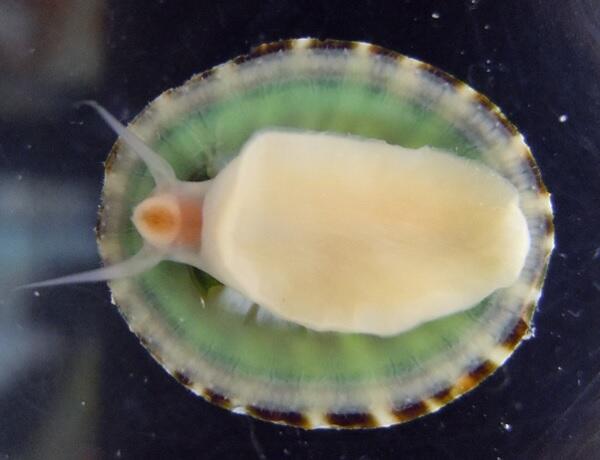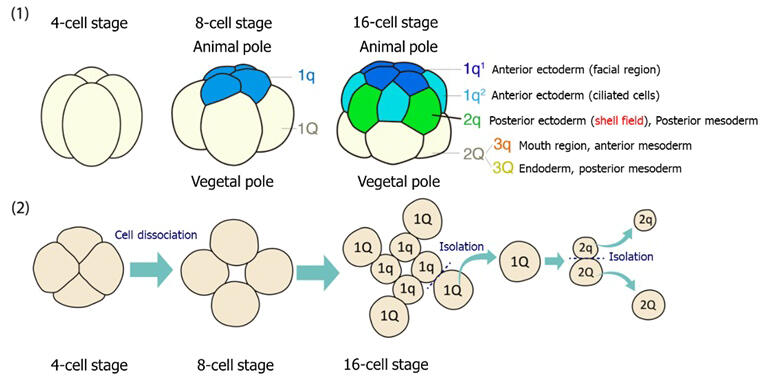Assistant Professor Yoshiaki Morino at the Institute of Life and Environmental Sciences, the University of Tsukuba, announced that he has verified how the cells that form shells in mollusks develop into specific tissues and revealed that the developmental fate of cells that form shells in gastropods is determined without induction from other cell lineages. This finding is expected to contribute to understanding biodiversity and its formation mechanisms. The results were published in the international scientific journal Development on April 4.

Provided by the University of Tsukuba
Shells exhibit diversity, and both gastropods and bivalves create their shells through the function of the mantle, a tissue in mollusks. Previous research has shown that cells involved in shell formation originate from a part of the second quartet of blastomeres formed during the 16-cell stage. Cell populations derived from the second quartet not only participate in shell formation during the larval stage but also differentiate into the mantle that functions in adult shell formation.
However, much remains unknown about how cells become shell-forming cells. For example, in 1952, Raven proposed an "induction hypothesis" based on findings from a type of gastropod, suggesting that "when the archenteron contacts the dorsal ectoderm, those dorsal ectodermal cells differentiate into shell-forming cells." This hypothesis has been widely accepted, but contradictions have also been reported, such as shell formation occurring even when cells that would become endoderm are removed before cultivation.
Therefore, the research group combined blastomere isolation culture techniques using fine needles to separate only the second quartet with gene expression analysis methods to test this induction hypothesis. Using a type of gastropod called Nipponacmea fuscoviridis, they investigated the repertoire of genes expressed in shell-forming cells.
As a result, they found that these cells are composed of at least three different cell types based on differences in gene expression. Based on the characteristics of the expressed genes, they suggested that among these three cell types, one is involved in forming the organic membrane constituting the outermost layer of the shell, while the remaining two are involved in forming the inner layer of the shell. Furthermore, when they analyzed the expression of genes involved in shell formation, they found that all the three cell types developed from the isolated and cultured second quartet-derived cell populations.

(1) Names of blastomeres at the 4- to 16-cell stages in mollusks and their typical developmental fates.
(2) Schematic of the isolated cell culture experiment. From 8-cell stage embryos, 1Q blastomeres were isolated. After the 1Q blastomeres divided into second quartet (2q) micromeres and large (2Q) macromeres, each was further isolated and cultured until 9 hours post-fertilization.
Provided by the University of Tsukuba
From these findings, it became clear that the fate of shell-forming cells is determined without induction from other cell lineages, contrary to the previously accepted induction hypothesis. In the future, they plan to investigate what roles each of the three identified cell types actually play in shell formation during the larval stage.
Morino commented: "By combining precise techniques for separating tiny blastomeres less than 0.1 millimeters in size with comprehensive gene expression analysis technologies, we were able to answer a long-standing question about the developmental fate of shell-forming cells. I look forward to using the results of this research as a steppingstone to clarify how the diverse shell forms of mollusks have evolved. I would like to express my sincere gratitude to everyone in the laboratory who contributed to conducting this research."
Journal Information
Publication: Development
Title: Characterization of shell field populations in gastropods and their autonomous specification mechanism independent of inter-quartet interactions
DOI: 10.1242/dev.204538
This article has been translated by JST with permission from The Science News Ltd. (https://sci-news.co.jp/). Unauthorized reproduction of the article and photographs is prohibited.




